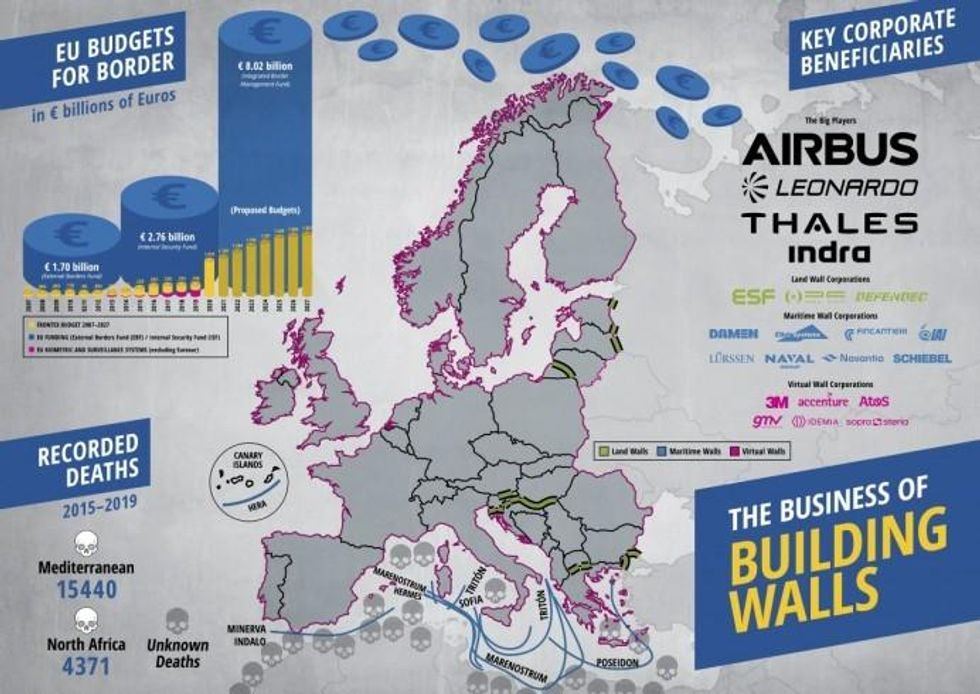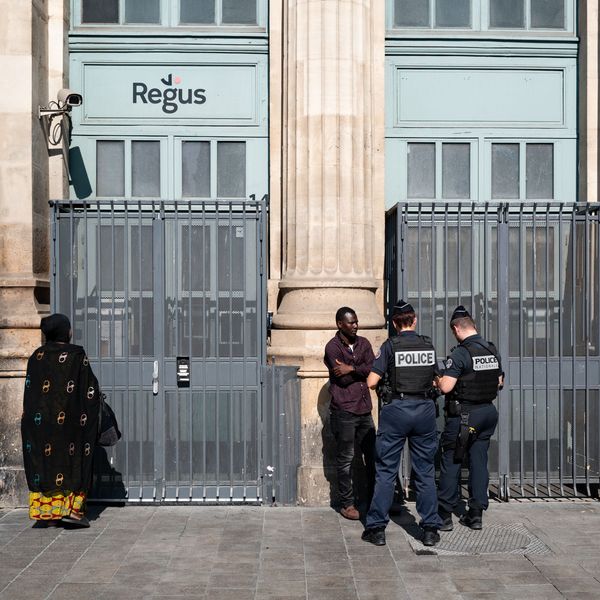
Police patrol the Hungarian border fence with Serbia on January 18, 2019 outside Szeged, Hungary. In 2015 thousands of migrants massed on the Hungarian border. The situation pushed Prime Minister Vicktor Orban's government to build a fence along its borders with Serbia, the resulting thirteen-foot-tall electric razor-wire fence has virtually halted immigration to the country. (Photo: Chris McGrath/Getty Images)
'The Business of Building Walls': New Report Shows Companies Cashing In on Europe's Expanding Anti-Migrant Barriers
"As we celebrate the fall of the Berlin Wall, it is tragic that so many new walls have been built across Europe to keep out the most vulnerable people on our planet."
There are plenty of headlines this week marking the 30th anniversary of the fall of the Berlin Wall on Saturday, but new walls in Europe are very much a big business.
That's the focus of a new report published Tuesday by the Transnational Institute (TNI), the Dutch campaign against the Arms Trade (Stop Wapenhandel), and Delas Center.
Entitled "The Business of Building Walls," the publication builds on the groups' 2018 report on walls. It names the beneficiaries of this new wave of barriers, which include not just physical walls but also "radar systems to the drones to the surveillance cameras to the biometric fingerprinting systems"--all aimed at blocking refugees and migrants.
This business, the report adds, "has both fueled and benefited from a massive expansion of public spending on border security by the European Union (EU) and its member states."
"As we celebrate the fall of the Berlin Wall, it is tragic that so many new walls have been built across Europe to keep out the most vulnerable people on our planet," said Niamh Ni Bhriain of TNI. "This report shows that the new era of building walls is driven by a powerful military and security industry that have shaped EU border policies and reaped the financial rewards."
\u201c30 years after we celebrated the fall of the #BerlinWall the EU and its member states have spent billions of euros on building walls and have budgeted to spend even more. \n\nWhy are there more walls than ever? https://t.co/Wcs4rHNOzE\n\n#berlinwall30\u201d— Transnational Institute (@Transnational Institute) 1572939000
Since 1989, "European countries have constructed about 1,000 kilometers of border walls and fences, more than six times the length of the Berlin Wall, to keep out refugees and migrants. Most of these have been built since 2015, when Syria's civil war was at its height," says the report. While Europe had just two walls in the 1990s, the number shot up to 15 in 2019, which combine to a length of 1,000 kilometers.
If anti-refugee maritime operations are included to the count ships, aircraft, and drones used to patrol the Mediterranean, the length of Europe's walls add an additional 4,750 kilometers.
Building Fortress Europe comes with costs, as a press release accompanying the report sums up:
Data shows at least EUR900 million has been spent on land walls and fences, EUR676.4 million on maritime operations (2006 to 2017), and EUR999.4m on its virtual walls (2000-2019).
Winners and losers of the wall business are evident:
A Europe full of walls has proved to be very good for the bottom line of a wide range of corporations including arms, security, IT, shipping and construction companies. The EU's planned budgets for border security for the next decade show it is also a business that will continue to boom.
Three European military firms--Thales, Leonardo, and Airbus--have been the biggest beneficiaries, according to the analysis. It notes that:
- Thales also produces maritime surveillance systems for drones and is working on developing border surveillance infrastructure for Eurosur, researching how to track and control refugees before they reach Europe by using smartphone apps, as well as exploring the use of High Altitude Pseudo Satellites (HAPS) for border security, for the European Space Agency and Frontex.
- Leonardo was also a member of a consortium, awarded EUR142.1 million in 2019 to implement and maintain EU's virtual walls, namely its EES. It jointly owns Telespazio with Thales, involved in EU satellite observation projects (REACT and Copernicus) used for border surveillance.
- Pan-European arms giant Airbus is a key supplier of helicopters used in patrolling maritime and some land borders, deployed by Belgium, France, Germany, Greece, Italy, Lithuania and Spain, including in maritime Operations Sophia, Poseidon and Triton.
"Perversely," says the report, "these firms are also among the top four biggest European arms dealers to the Middle East and North Africa, thus contributing to the conflicts that cause forced migration."

This is also a deadly business. The heavy militarization of Europe's borders on land and at sea has led refugees and migrants to follow far more hazardous routes and has trapped others in desperate conditions in neighboring countries like Libya. Many deaths are not recorded, but those that are tracked in the Mediterranean show that the proportion of those who drown trying to reach Europe continues to increase each year.
The report's author, Mark Akkerman, called for a new, more humane approach to help those uprooted from their homelands.
"Today's walls," he wrote, "need to be replaced by policies based on providing shelter, assistance, and a safe future for refugees as well as working on eliminating the reasons people are forced to leave their homes in the first place."
An Urgent Message From Our Co-Founder
Dear Common Dreams reader, The U.S. is on a fast track to authoritarianism like nothing I've ever seen. Meanwhile, corporate news outlets are utterly capitulating to Trump, twisting their coverage to avoid drawing his ire while lining up to stuff cash in his pockets. That's why I believe that Common Dreams is doing the best and most consequential reporting that we've ever done. Our small but mighty team is a progressive reporting powerhouse, covering the news every day that the corporate media never will. Our mission has always been simple: To inform. To inspire. And to ignite change for the common good. Now here's the key piece that I want all our readers to understand: None of this would be possible without your financial support. That's not just some fundraising cliche. It's the absolute and literal truth. We don't accept corporate advertising and never will. We don't have a paywall because we don't think people should be blocked from critical news based on their ability to pay. Everything we do is funded by the donations of readers like you. Will you donate now to help power the nonprofit, independent reporting of Common Dreams? Thank you for being a vital member of our community. Together, we can keep independent journalism alive when it’s needed most. - Craig Brown, Co-founder |
There are plenty of headlines this week marking the 30th anniversary of the fall of the Berlin Wall on Saturday, but new walls in Europe are very much a big business.
That's the focus of a new report published Tuesday by the Transnational Institute (TNI), the Dutch campaign against the Arms Trade (Stop Wapenhandel), and Delas Center.
Entitled "The Business of Building Walls," the publication builds on the groups' 2018 report on walls. It names the beneficiaries of this new wave of barriers, which include not just physical walls but also "radar systems to the drones to the surveillance cameras to the biometric fingerprinting systems"--all aimed at blocking refugees and migrants.
This business, the report adds, "has both fueled and benefited from a massive expansion of public spending on border security by the European Union (EU) and its member states."
"As we celebrate the fall of the Berlin Wall, it is tragic that so many new walls have been built across Europe to keep out the most vulnerable people on our planet," said Niamh Ni Bhriain of TNI. "This report shows that the new era of building walls is driven by a powerful military and security industry that have shaped EU border policies and reaped the financial rewards."
\u201c30 years after we celebrated the fall of the #BerlinWall the EU and its member states have spent billions of euros on building walls and have budgeted to spend even more. \n\nWhy are there more walls than ever? https://t.co/Wcs4rHNOzE\n\n#berlinwall30\u201d— Transnational Institute (@Transnational Institute) 1572939000
Since 1989, "European countries have constructed about 1,000 kilometers of border walls and fences, more than six times the length of the Berlin Wall, to keep out refugees and migrants. Most of these have been built since 2015, when Syria's civil war was at its height," says the report. While Europe had just two walls in the 1990s, the number shot up to 15 in 2019, which combine to a length of 1,000 kilometers.
If anti-refugee maritime operations are included to the count ships, aircraft, and drones used to patrol the Mediterranean, the length of Europe's walls add an additional 4,750 kilometers.
Building Fortress Europe comes with costs, as a press release accompanying the report sums up:
Data shows at least EUR900 million has been spent on land walls and fences, EUR676.4 million on maritime operations (2006 to 2017), and EUR999.4m on its virtual walls (2000-2019).
Winners and losers of the wall business are evident:
A Europe full of walls has proved to be very good for the bottom line of a wide range of corporations including arms, security, IT, shipping and construction companies. The EU's planned budgets for border security for the next decade show it is also a business that will continue to boom.
Three European military firms--Thales, Leonardo, and Airbus--have been the biggest beneficiaries, according to the analysis. It notes that:
- Thales also produces maritime surveillance systems for drones and is working on developing border surveillance infrastructure for Eurosur, researching how to track and control refugees before they reach Europe by using smartphone apps, as well as exploring the use of High Altitude Pseudo Satellites (HAPS) for border security, for the European Space Agency and Frontex.
- Leonardo was also a member of a consortium, awarded EUR142.1 million in 2019 to implement and maintain EU's virtual walls, namely its EES. It jointly owns Telespazio with Thales, involved in EU satellite observation projects (REACT and Copernicus) used for border surveillance.
- Pan-European arms giant Airbus is a key supplier of helicopters used in patrolling maritime and some land borders, deployed by Belgium, France, Germany, Greece, Italy, Lithuania and Spain, including in maritime Operations Sophia, Poseidon and Triton.
"Perversely," says the report, "these firms are also among the top four biggest European arms dealers to the Middle East and North Africa, thus contributing to the conflicts that cause forced migration."

This is also a deadly business. The heavy militarization of Europe's borders on land and at sea has led refugees and migrants to follow far more hazardous routes and has trapped others in desperate conditions in neighboring countries like Libya. Many deaths are not recorded, but those that are tracked in the Mediterranean show that the proportion of those who drown trying to reach Europe continues to increase each year.
The report's author, Mark Akkerman, called for a new, more humane approach to help those uprooted from their homelands.
"Today's walls," he wrote, "need to be replaced by policies based on providing shelter, assistance, and a safe future for refugees as well as working on eliminating the reasons people are forced to leave their homes in the first place."
There are plenty of headlines this week marking the 30th anniversary of the fall of the Berlin Wall on Saturday, but new walls in Europe are very much a big business.
That's the focus of a new report published Tuesday by the Transnational Institute (TNI), the Dutch campaign against the Arms Trade (Stop Wapenhandel), and Delas Center.
Entitled "The Business of Building Walls," the publication builds on the groups' 2018 report on walls. It names the beneficiaries of this new wave of barriers, which include not just physical walls but also "radar systems to the drones to the surveillance cameras to the biometric fingerprinting systems"--all aimed at blocking refugees and migrants.
This business, the report adds, "has both fueled and benefited from a massive expansion of public spending on border security by the European Union (EU) and its member states."
"As we celebrate the fall of the Berlin Wall, it is tragic that so many new walls have been built across Europe to keep out the most vulnerable people on our planet," said Niamh Ni Bhriain of TNI. "This report shows that the new era of building walls is driven by a powerful military and security industry that have shaped EU border policies and reaped the financial rewards."
\u201c30 years after we celebrated the fall of the #BerlinWall the EU and its member states have spent billions of euros on building walls and have budgeted to spend even more. \n\nWhy are there more walls than ever? https://t.co/Wcs4rHNOzE\n\n#berlinwall30\u201d— Transnational Institute (@Transnational Institute) 1572939000
Since 1989, "European countries have constructed about 1,000 kilometers of border walls and fences, more than six times the length of the Berlin Wall, to keep out refugees and migrants. Most of these have been built since 2015, when Syria's civil war was at its height," says the report. While Europe had just two walls in the 1990s, the number shot up to 15 in 2019, which combine to a length of 1,000 kilometers.
If anti-refugee maritime operations are included to the count ships, aircraft, and drones used to patrol the Mediterranean, the length of Europe's walls add an additional 4,750 kilometers.
Building Fortress Europe comes with costs, as a press release accompanying the report sums up:
Data shows at least EUR900 million has been spent on land walls and fences, EUR676.4 million on maritime operations (2006 to 2017), and EUR999.4m on its virtual walls (2000-2019).
Winners and losers of the wall business are evident:
A Europe full of walls has proved to be very good for the bottom line of a wide range of corporations including arms, security, IT, shipping and construction companies. The EU's planned budgets for border security for the next decade show it is also a business that will continue to boom.
Three European military firms--Thales, Leonardo, and Airbus--have been the biggest beneficiaries, according to the analysis. It notes that:
- Thales also produces maritime surveillance systems for drones and is working on developing border surveillance infrastructure for Eurosur, researching how to track and control refugees before they reach Europe by using smartphone apps, as well as exploring the use of High Altitude Pseudo Satellites (HAPS) for border security, for the European Space Agency and Frontex.
- Leonardo was also a member of a consortium, awarded EUR142.1 million in 2019 to implement and maintain EU's virtual walls, namely its EES. It jointly owns Telespazio with Thales, involved in EU satellite observation projects (REACT and Copernicus) used for border surveillance.
- Pan-European arms giant Airbus is a key supplier of helicopters used in patrolling maritime and some land borders, deployed by Belgium, France, Germany, Greece, Italy, Lithuania and Spain, including in maritime Operations Sophia, Poseidon and Triton.
"Perversely," says the report, "these firms are also among the top four biggest European arms dealers to the Middle East and North Africa, thus contributing to the conflicts that cause forced migration."

This is also a deadly business. The heavy militarization of Europe's borders on land and at sea has led refugees and migrants to follow far more hazardous routes and has trapped others in desperate conditions in neighboring countries like Libya. Many deaths are not recorded, but those that are tracked in the Mediterranean show that the proportion of those who drown trying to reach Europe continues to increase each year.
The report's author, Mark Akkerman, called for a new, more humane approach to help those uprooted from their homelands.
"Today's walls," he wrote, "need to be replaced by policies based on providing shelter, assistance, and a safe future for refugees as well as working on eliminating the reasons people are forced to leave their homes in the first place."

